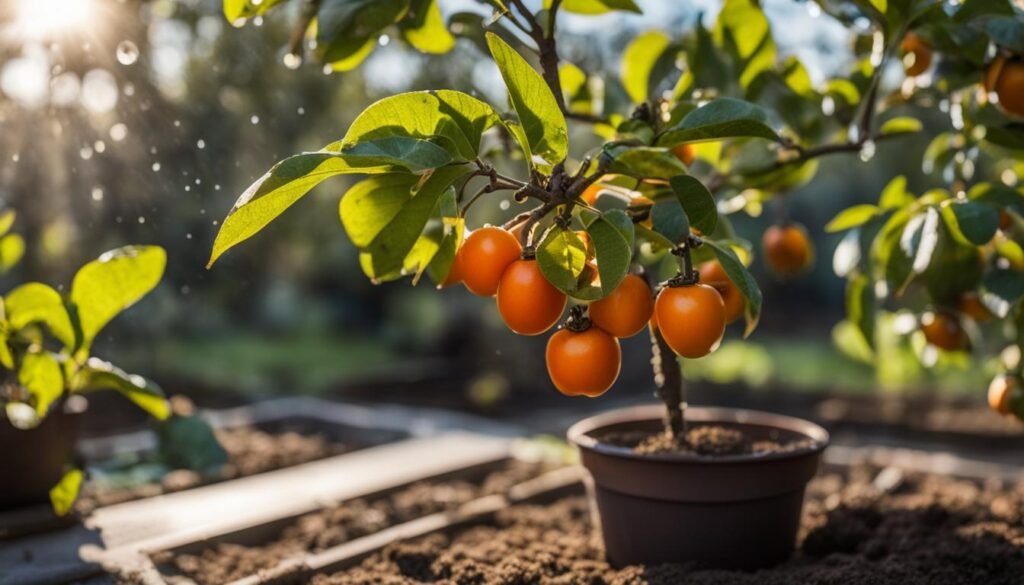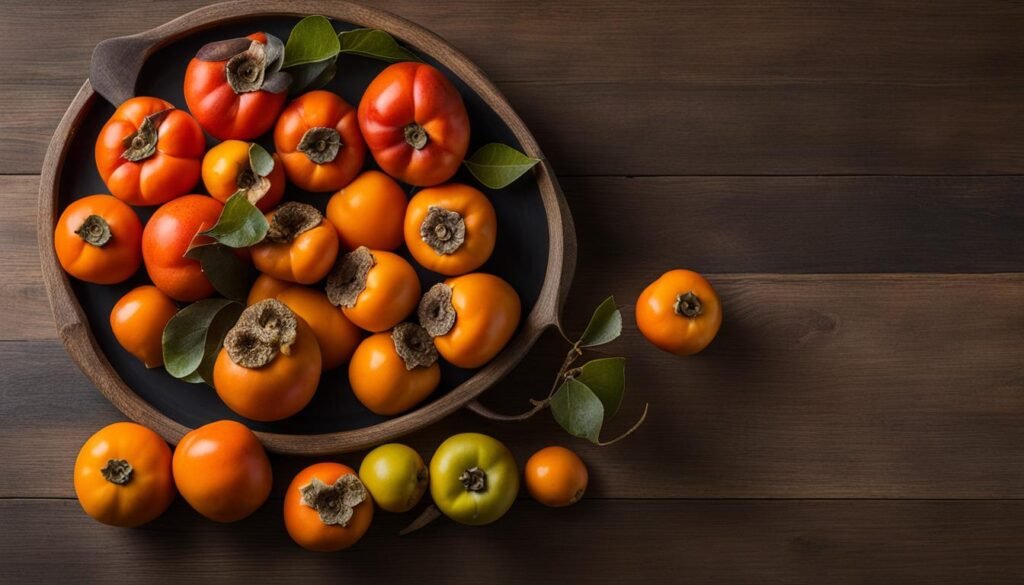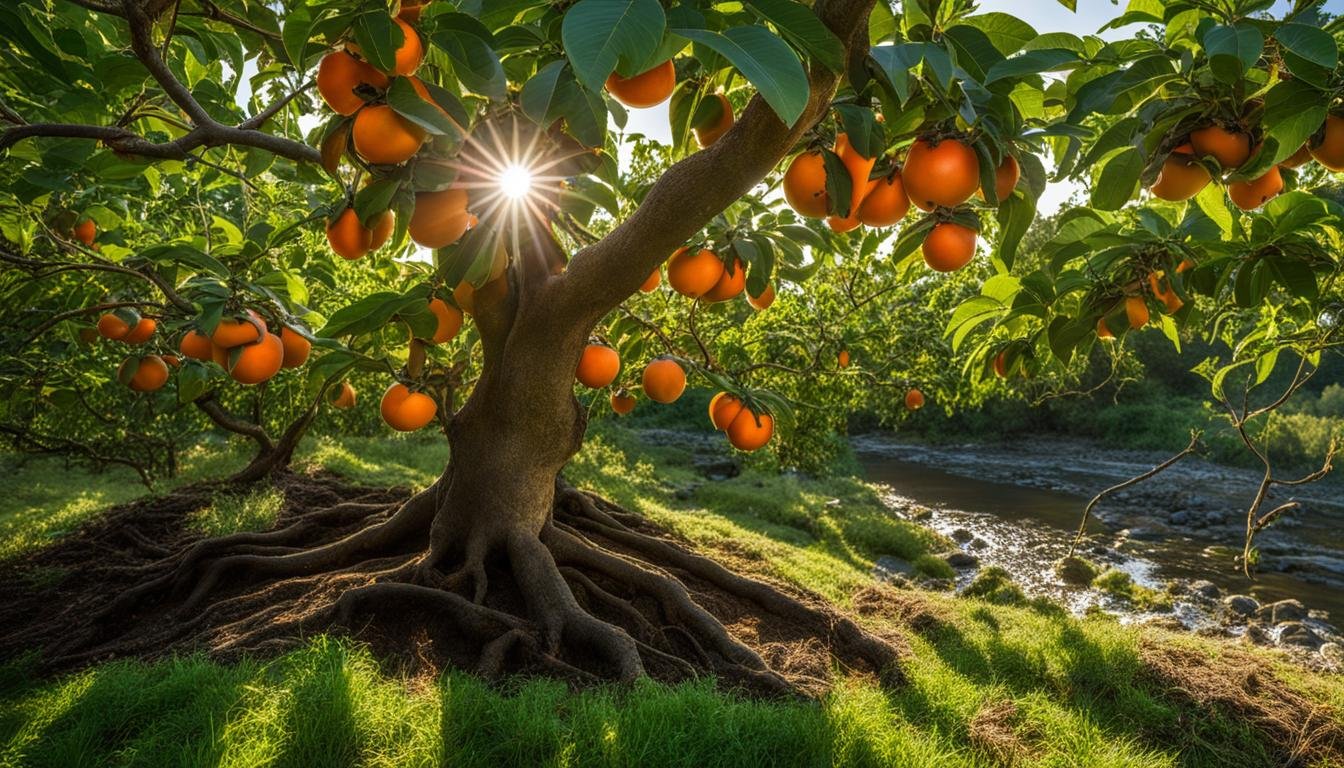Welcome to my guide on successfully growing American persimmons! If you’re looking to cultivate these delicious fruits in your backyard, you’ve come to the right place. American persimmons, also known as D. virginiana, are not only easy to care for but also offer exceptional flavor and versatility. Whether you’re a seasoned gardener or a beginner, this guide will provide you with all the information you need to successfully grow and enjoy these native fruits.
Key Takeaways:
- American persimmons, also known as D. virginiana, are easy to care for and produce exceptionally flavorful fruit.
- They are more pest and disease resistant compared to Asian persimmons, making them an excellent choice for cultivation.
- American persimmons have a rich history and were traditionally valued by Native Americans for their taste and nutritional value.
- They can be propagated through cuttings or seeds, and proper pruning and training techniques can help maintain their health and productivity.
- Choosing the right cultivars, providing adequate sunlight and well-draining soil, and managing pests and diseases are crucial for successful cultivation.
What is the American Persimmon?
The American persimmon, also known as D. virginiana, is a native fruit tree found in the southern and eastern regions of the United States. It is closely related to the Asian persimmon, D. kaki, but has a more flavorful fruit. The American persimmon is known for its stunning fall foliage and produces small, round fruits that ripen in the fall. These fruits are best known for their complex and sweet flavor.
Unlike the Asian persimmon, the American persimmon is more pest and disease resistant and has better cold tolerance. This makes it a popular choice for home gardeners looking to grow their own persimmons. Whether you’re a fruit enthusiast or just looking to add a unique and delicious tree to your landscape, the American persimmon is a fantastic option.
The American persimmon produces exceptionally flavorful fruit that is complex and sweet, with a texture like heavenly pudding.
With its rich history and native status, the American persimmon has been enjoyed for centuries. Native Americans traditionally gathered the fruit in the wild, appreciating its taste and nutritional value. European settlers later discovered and incorporated the fruit into their diets as well. Today, cultivation of American persimmons continues to thrive, with breeders working to improve the tree’s pest and disease resistance, as well as the quality of its fruit.
| American Persimmon (D. virginiana) | Asian Persimmon (D. kaki) |
|---|---|
| Better pest and disease resistance | Less pest and disease resistant |
| Superior cold tolerance | Less cold tolerant |
| Complex and sweet flavor | Varies in flavor, some varieties are astringent until fully ripe |
| Native to the United States | Native to Asia |
Cultivation and History
When it comes to the cultivation and history of American persimmons, there is a rich heritage that dates back to the time of Native Americans. These native fruits were highly valued for their taste and nutritional benefits, leading to their widespread gathering in the wild by indigenous tribes. European settlers later recognized the value of American persimmons and started cultivating them in the late 1800s.
Over the years, dedicated breeders have worked on improving the pest and disease resistance as well as the fruit quality of American persimmon trees. Today, these trees can be found in orchards across the United States, making it easier for both commercial growers and backyard gardeners to enjoy the beauty and flavor of these native fruits.
By delving into the cultivation and history of American persimmons, we gain a deeper appreciation for these unique fruits and the cultural significance they hold. Let’s explore the journey of American persimmons from their wild origins to the cultivated trees we know today.
Native Americans’ Appreciation for American Persimmons
The Native Americans recognized the value of American persimmons, incorporating them into their diets and utilizing their various medicinal properties. They would gather the ripe fruits in the fall and consume them fresh or dry them for later use. The sweet and tangy flavor of American persimmons made them a popular choice, and they were often enjoyed in recipes or used as a natural sweetener.
The Native Americans cherished the native fruit for its taste and nutritional value. American persimmons became a staple in their diet, and they held cultural significance in many tribes.
The Rise of Cultivation
As European settlers arrived in North America, they also recognized the appeal of American persimmons and started cultivating them. The first documented cultivation of American persimmons began in the late 1800s, with growers selectively breeding trees for improved fruit quality and tree vigor. This marked the beginning of a new era for American persimmons, as they transitioned from wild fruits to cultivated trees.
Since then, breeders and horticultural enthusiasts have continued to refine the cultivation techniques for American persimmons, leading to the development of new varieties with enhanced traits. Today, numerous cultivars are available, each with its own characteristics and flavor profiles.
Cultivation of American persimmons not only ensures a reliable supply of these delicious fruits but also contributes to the preservation of their genetic diversity and cultural heritage. By growing American persimmons, we connect with the land, history, and the vibrant tapestry of the past.
Propagation
When it comes to propagating American persimmons, there are two main methods you can use: cuttings and seeds. Each method has its own advantages and considerations, so let’s take a closer look at how to successfully propagate these delicious fruit trees.
Cuttings: Propagating American persimmons from cuttings is a common method used by many gardeners. To do this, you’ll want to take hardwood cuttings from mature shoots in the autumn. These cuttings should be about 8-10 inches long with several leaf nodes. Before planting the cuttings, it’s important to treat them with a rooting hormone to encourage root development. Once treated, plant the cuttings in well-draining soil and keep them moist. With proper care, the cuttings should establish roots and grow into healthy young trees.
Seeds: Another option for propagating American persimmons is through seeds. Start by soaking the persimmon seeds in water for a few days to soften the seed coat. After soaking, plant the seeds in a container with potting soil. It’s important to note that persimmon seeds require cold stratification, which means they need a period of cold temperatures to break dormancy. Place the container in the refrigerator for about three months, ensuring the soil remains moist. Once the stratification period is complete, transfer the container to a warm and bright location to encourage germination. From there, you can transplant the seedlings into individual pots or directly into the ground.
Both methods of propagation have their pros and cons. Cuttings allow you to reproduce the exact characteristics of a known cultivar, while seeds can result in more genetic diversity and potentially new varieties. Whichever method you choose, patience and proper care are key to successfully propagating American persimmons.
| Method | Advantages | Considerations |
|---|---|---|
| Cuttings | – Reproduces known cultivar characteristics – Faster establishment |
– Requires rooting hormone treatment – Not suitable for genetic diversity |
| Seeds | – Potential for new varieties – Genetic diversity |
– Requires cold stratification – Longer establishment time |
How to Grow American Persimmons
When it comes to growing persimmons, there are a few key factors to keep in mind to ensure successful cultivation. First and foremost, American persimmons thrive in full sun, so it’s important to choose a location in your garden that receives ample sunlight throughout the day. This will help the trees produce the best quality fruit.
In terms of soil, American persimmons are relatively adaptable and can tolerate a wide range of soil types. However, well-draining soil is essential to prevent root rot. If your soil tends to be heavy or compacted, consider amending it with organic matter such as compost or peat moss to improve drainage.
Watering is crucial during the growing season, especially when the fruits are developing. While persimmons are relatively drought-tolerant once established, it’s important to water deeply at the roots to ensure the tree has access to an adequate water supply. This is particularly important during the hot summer months.
Fertilizer is generally not necessary for healthy persimmon trees, as they are able to extract nutrients from the soil efficiently. However, if you notice slow growth or yellowing leaves, a slow-release balanced fertilizer can be applied in late winter or early spring to provide an extra boost. Remember to follow the instructions on the fertilizer package and avoid over-fertilizing, as this can lead to excessive vegetative growth at the expense of fruit production.

Table: Sunlight, Soil, Watering, and Fertilizer Guidelines
| Aspect | Guidelines |
|---|---|
| Sunlight | Full sun |
| Soil | Well-draining soil with organic matter |
| Watering | Water deeply at the roots, especially during fruit development |
| Fertilizer | Generally not necessary, but a slow-release balanced fertilizer can be applied if needed |
By following these guidelines, you can ensure optimal growth and fruit production for your American persimmon trees. Remember to monitor their progress, provide regular care and maintenance, and enjoy the bountiful harvest of these delicious fruits.
Pruning, Training, and Maintenance
Pruning plays a crucial role in maintaining the health and structure of American persimmon trees. It helps to remove dead or diseased branches, encourages proper airflow and sunlight penetration, and prevents branches from becoming overloaded with fruit. Pruning is typically minimal for American persimmons, but it should be done strategically to maintain a balanced branch structure.
When pruning young trees, it is recommended to shape them into a central leader structure. This involves selecting a strong central branch to serve as the main trunk and removing competing branches. As the tree matures, corrective pruning may be necessary to eliminate any crossed or rubbing branches. It’s important to make clean cuts just above a bud or lateral branch junction to promote proper healing.
In terms of training, it can be beneficial to encourage branches to spread out from the main trunk. This helps to ensure that each branch receives adequate sunlight and allows for good air circulation throughout the tree. By training the branches to grow horizontally, you can prevent the development of a dense and congested canopy.
Benefits of Pruning and Training:
- Promotes proper airflow and sunlight penetration
- Prevents overload of branches with fruit
- Maintains a balanced branch structure
- Allows for better pest and disease management
In terms of maintenance, regular inspections should be conducted to identify any signs of pest or disease infestation. Prompt action should be taken to control and manage these issues to prevent further damage to the tree. Additionally, providing the tree with proper nutrition and watering it deeply at the roots will help support healthy growth and fruit production.
Remember, maintaining a well-pruned and trained American persimmon tree not only enhances its visual appeal but also ensures optimal fruit yield and overall health.

Table: Comparison of American Persimmon Cultivars
| Cultivar | Flavor | Texture | Astringency |
|---|---|---|---|
| ‘Fuyu’ | Sweet and nutty | Crisp | Non-astringent |
| ‘Izu’ | Sweet and flavorful | Creamy | Non-astringent |
| ‘Hachiya’ | Rich and sweet | Jelly-like when ripe | Astringent |
Managing Pests and Disease
When cultivating American persimmons, it’s important to be aware of potential pests and diseases that can affect these trees. While American persimmons are generally more resistant to such issues compared to Asian persimmons, it’s still crucial to take preventive measures and promptly address any problems that arise. By implementing proper pest control and disease management techniques, you can ensure the health and longevity of your persimmon trees.
Common Pests
Some common pests that may infest American persimmons include mealybugs, aphids, and scale insects. These small insects can cause damage to the leaves and fruits of the trees if left untreated. To control these pests, consider using neem oil or insecticidal soap, both of which are effective and environmentally friendly options for pest management.
Disease Management
American persimmons can be susceptible to certain diseases, such as crown gall and leaf blight. To manage these diseases, it’s important to regularly inspect your trees for any signs of infection, such as discolored or wilting leaves, lesions, or unusual growths. If you notice any symptoms, consult with a local agricultural extension office or a professional arborist to identify the specific disease and determine the appropriate course of action. Fungicides may be necessary in some cases, but prevention through good tree maintenance practices, such as pruning and providing adequate air circulation, is key to minimizing disease risks.
| Pest/Disease | Symptoms | Prevention/Management |
|---|---|---|
| Mealybugs | White, cottony clusters on leaves and fruit | – Use neem oil or insecticidal soap – Regularly inspect trees for infestations – Prune and remove affected branches |
| Aphids | Small, soft-bodied insects clustered on new growth | – Use neem oil or insecticidal soap – Encourage natural predators, such as ladybugs – Apply organic foliar sprays |
| Scale Insects | Hard, shell-like coverings on branches and leaves | – Use neem oil or insecticidal soap – Prune and remove affected branches – Improve tree vigor through proper care |
| Crown Gall | Large, swollen growths on roots and lower trunk | – Plant disease-resistant cultivars – Avoid mechanical injuries to roots – Maintain good soil drainage |
| Leaf Blight | Brown spots on leaves, withering and defoliation | – Practice good sanitation and hygiene – Remove and destroy infected leaves – Apply appropriate fungicides if necessary |
By taking proactive measures and staying vigilant in managing pests and diseases, you can ensure that your American persimmon trees thrive and produce abundant, high-quality fruit for years to come.

Conclusion
Growing American persimmons can be a rewarding experience, both in terms of the beauty of the tree and the deliciousness of the fruit it produces. By following the tips and guidelines outlined in this guide, you can successfully cultivate American persimmons in your backyard.
Remember to choose the right cultivars for your growing conditions, provide proper care and maintenance, and manage any potential pest or disease issues. With a little patience and perseverance, you can enjoy the flavorful fruits of your labor for years to come.
FAQ
What is the ideal growing environment for American persimmons?
American persimmons thrive in full sun and can tolerate a variety of soil types, as long as it is well-draining to prevent root rot.
How often should I water my American persimmon tree?
Water deeply at the roots, especially during the summer when the fruit is developing. Ensure the soil is moist, but not waterlogged.
Do American persimmons require fertilizer?
Generally, American persimmons do not require fertilizer. However, a slow-release balanced fertilizer can be applied in late winter or early spring if needed.
How should I prune my American persimmon tree?
Minimal pruning is necessary for American persimmon trees. Young trees can be pruned to maintain a central leader shape, while older trees may require corrective pruning to remove dead or diseased branches.
Is it necessary to protect American persimmon trees from strong winds?
Providing protection from strong winds can help prevent damage to the tree and enhance its overall health and longevity.
Which cultivars of American persimmons should I choose for my garden?
Popular cultivars include ‘Fuyu’, ‘Izu’, and ‘Hachiya’. Select cultivars that are suited to your specific growing conditions and preferences in terms of taste and texture.
How can I manage pests and diseases that may affect my American persimmon tree?
Common pests such as mealybugs, aphids, and scale insects can be controlled with neem oil or insecticidal soap. Diseases like crown gall and leaf blight can be treated with appropriate fungicides. Good maintenance practices, such as pruning and maintaining air circulation, can also help prevent and manage pest and disease issues.




